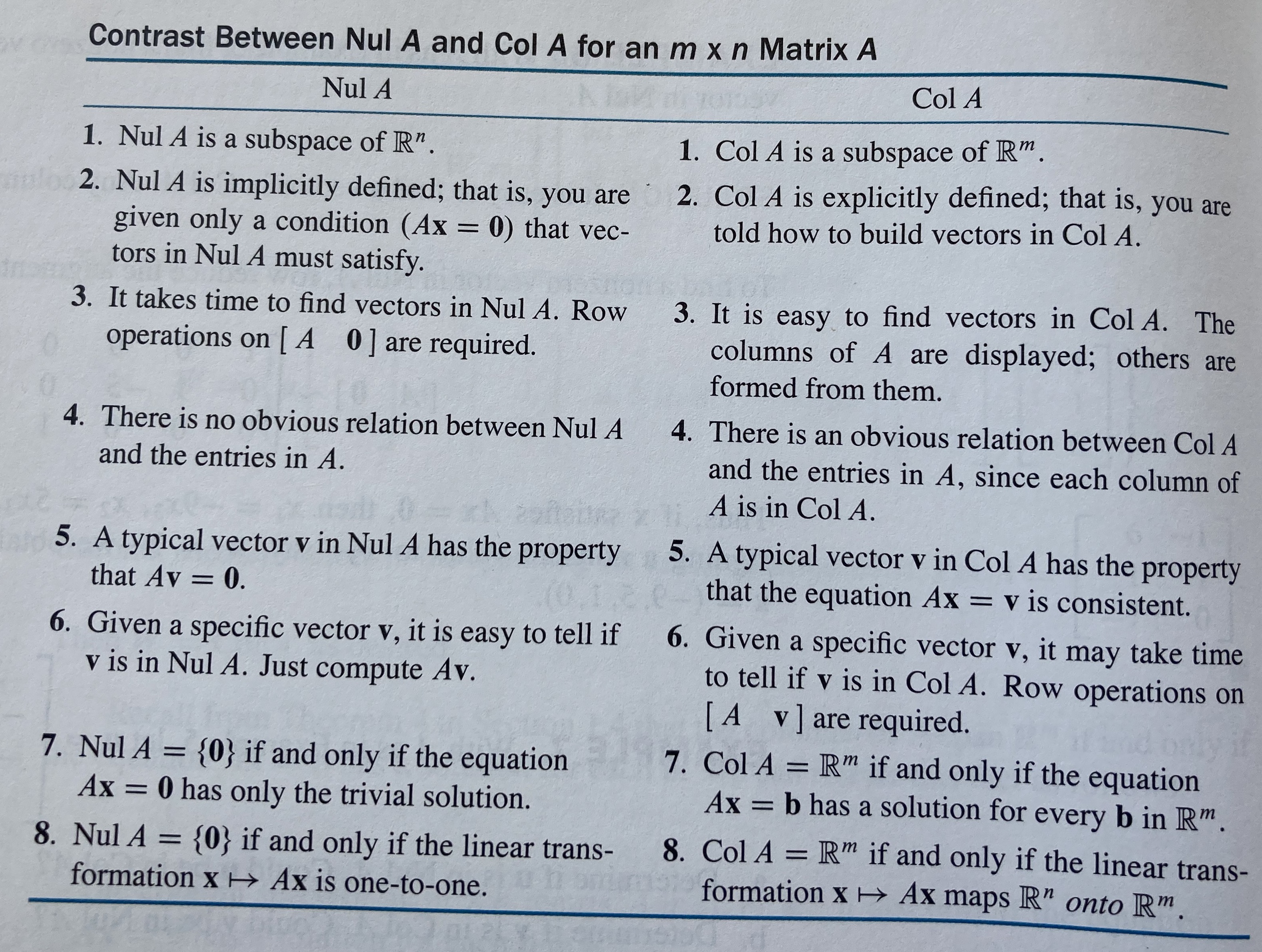Chapter 15 Vector Spaces and Subspaces
Recall the definition of a subspace:
Definition 15.1 A subspace \(\mathcal{H}\) of a vector space \(\mathcal{V}\) is a subset of \(\mathcal{V}\) such that
\(\mathcal{H}\) contains the zero vector – \(\mathbf{0} \in \mathcal{H}\)
\(\mathcal{H}\) is closed under vector addition. Therefore, for \(\mathbf{u}\) and \(\mathbf{v}\) in \(\mathcal{H}\), the sum \(\mathbf{u} + \mathbf{v}\) is in \(\mathcal{H}\)
\(\mathcal{H}\) is closed under scalar multiplication. Therefore, for \(\mathbf{u}\) in \(\mathcal{H}\) and a scalar \(a\), the product \(a \mathbf{u}\) is in \(\mathcal{H}\)
A consequence of this definition is that a subspace \(\mathcal{H}\) is closed under linear combinations.
15.1 Null space and column space
Also, recall the special subspaces of the column space and the null space.
15.1.1 Null space
Definition 15.2 The null space null(\(\mathbf{A}\)) of an \(m \times n\) \(\mathbf{A}\) is the set of all solutions of the homogeneous equation \(\mathbf{A} \mathbf{x} = \mathbf{0}\)
Another way to write null(\(\mathbf{A}\)) is \[ \begin{aligned} \mbox{null}(\mathbf{A}) = \{\mathbf{x} : \mathbf{x} \in \mathcal{R}^n \mbox{ and } \mathbf{A} \mathbf{x} = \mathbf{0} \} \end{aligned} \]
Theorem 15.1 The null space of an \(m \times n\) matrix \(\mathbf{A}\) is a subspace of \(\mathcal{R}^n\).
Proof. To show that the null space of \(\mathbf{A}\), denoted null(\(\mathbf{A})\), is a subspace we need to show the following
The zero vector \(\mathbf{0}\) is in the null space of \(\mathbf{A}\)
The null space of \(\mathbf{A}\) is closed under addition
The null space of \(\mathbf{A}\) is closed under scalar multiplication
The null space of \(\mathbf{A}\) is defined as the set of vectors \(\mathbf{x}\) such that \(\mathbf{A} \mathbf{x} = \mathbf{0}\).
First, we show that the zero vector is in the subspace by setting \(\mathbf{x} = \mathbf{0}\). Thus, because \(\mathbf{A} \mathbf{0} = \mathbf{0}\), the zero vector \(\mathbf{0}\) is in the null space of \(\mathbf{A}\) .
Next, let \(\mathbf{u}\) and \(\mathbf{v}\) be vectors in the null space of \(\mathbf{A}\). Thus, by the definition of the null space we have \(\mathbf{A} \mathbf{u} = \mathbf{0}\) and \(\mathbf{A} \mathbf{v} = \mathbf{0}\). Consider the vector \(\mathbf{u} + \mathbf{v}\) and consider \(\mathbf{A} (\mathbf{u} + \mathbf{v}) = \mathbf{A} \mathbf{u} + \mathbf{A} \mathbf{v} = \mathbf{0} + \mathbf{0} = \mathbf{0}\). Thus \(\mathbf{u} + \mathbf{v}\) is in the null space of \(\mathbf{A}\).
Finally, let \(\mathbf{u}\) be a vector in the null space of \(\mathbf{A}\) and let \(c\) be a scalar. Thus, by the definition of the null space we have \(\mathbf{A} \mathbf{u} = \mathbf{0}\). Then, consider \(\mathbf{A} (c \mathbf{u}) = c \mathbf{A} \mathbf{u} = c \mathbf{0} = \mathbf{0}\)
Because the three requirements for a subspace are met, this gives us that the null space of \(\mathbf{A}\) is a subspace.
As a consequence, there will exist a set of vectors that span the null space null(\(\mathbf{A}\)). However, the null space of \(\mathbf{A}\) is defined implicitly. This means that the null space of \(\mathbf{A}\) is not obvious given the vectors of \(\mathbf{A}\) and must be checked/calculated.
- In class
Find a spanning set for null(\(\mathbf{A}\)) where
\[ \begin{aligned} \mathbf{A} = \begin{pmatrix} 7 & -2 & 7 & -4 & 5 \\ 2 & 0 & 3 & 3 & 9 \\ -5 & 2 & -5 & 7 & -2 \end{pmatrix} \end{aligned} \]
- Find solution to system of homogeneous system of equations \(\mathbf{A} \mathbf{x} = \mathbf{0}\)
## [,1] [,2] [,3] [,4] [,5] [,6]
## [1,] 1 0 0 1.50 -4.50 0
## [2,] 0 1 0 7.25 2.75 0
## [3,] 0 0 1 0.00 6.00 0Take the general solution and write as a linear combination of vectors where the coefficients are the free variables.
general solution \(x_1 = -1.5 x_4 + 4.5 x_5\), \(x_2 = -7.25 x_4 - 2.75 x_5\), \(x_3 = -6 x_5\) and both \(x_4\) and \(x_5\) are free. Write out the general solution in vector form.
\[ \begin{aligned} \begin{pmatrix} x_1 \\ x_2 \\ x_3 \\ x_4 \\ x_5 \end{pmatrix} = \begin{pmatrix} -1.5 x_4 + 4.5 x_5\\ -7.25 x_4 - 2.75 x_5 \\ -6 x_5 \\ x_4 \\ x_5 \end{pmatrix} = x_4 \begin{pmatrix} -1.5 \\ -7.25 \\ 0 \\ 1 \\ 0 \end{pmatrix} + x_5 \begin{pmatrix} 4.5 \\ 2.75 \\ -6 \\ 0 \\ 1 \end{pmatrix} \end{aligned} \]
- From above, the free variables \(x_4\) and \(x_5\) are multiplied by the vectors \(\mathbf{u} = \begin{pmatrix} -1.5 \\ -7.25 \\ 0 \\ 1 \\ 0 \end{pmatrix}\) and \(\mathbf{v} = \begin{pmatrix} 4.5 \\ 2.75 \\ -6 \\ 0 \\ 1 \end{pmatrix}\) where \(\{ \mathbf{u}, \mathbf{v} \}\) are a spanning set for the null(\(\mathbf{A}\))
- In class – do another Find a spanning set for null(\(\mathbf{A}\)) where
15.1.2 Column space
Definition 15.3 The columns space col(\(\mathbf{A}\)) of an \(m \times n\) \(\mathbf{A}\) is the set of all linear combinations of the columns of \(\mathbf{A}\).
If \(\{ \mathbf{a}_1, \ldots, \mathbf{a}_n\}\) are the columns of \(\mathbf{A}\), then \[ \begin{aligned} \mbox{col}(\mathbf{A}) = \mbox{span}(\mathbf{A}) \end{aligned} \] this can be written in set notation as \[ \begin{aligned} \mbox{col}(\mathbf{A}) = \{ \mathbf{b} : \mathbf{A} \mathbf{x} = \mathbf{b} \mbox{ for some } \mathbf{x} \in \mathcal{R}^n \} \end{aligned} \]
Theorem 15.2 The column space of an \(m \times n\) matrix \(\mathbf{A}\) is a subspace of \(\mathcal{R}^n\).
Proof. Do in class
\(\mathbf{0}\) vector
sum of vectors
scalar multiplication
Compared to the null space, the column space is defined explicitly–it is the span of the columns of \(\mathbf{A}\). The definition of the column space results in the fact that col(\(\mathbf{A}\)) is the range of the linear transformation \(\mathbf{x} \rightarrow \mathbf{A} \mathbf{x}\).
- In class
Find a spanning set for col(\(\mathbf{A}\)) where
\[ \begin{aligned} \mathbf{A} = \begin{pmatrix} 6 & 0 & 4 \\ 5 & -1 & -9 \\ -4 & 7 & 4 \\ 6 & 2 & 9 \end{pmatrix} \end{aligned} \]
15.1.3 Understanding the differerneces between the column space and the null space
